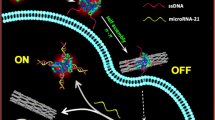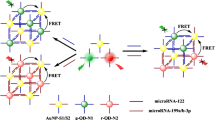Abstract
An ultrasensitive and highly reliable ratiometric assay is described for the determination of microRNA-155. It works at the attomolar concentration level and has high selectivity which warrants its potential application in cancer biomarker tracking. The excellent performance of this method results from (a) the use of a hybrid conjugate prepared from Rhodamine B (RhB), carbon dots (CDs) and probe-microRNA, and (b) from the measurement of fluorescence resonance energy transfer (FRET) that is observed in the AuNP/target-microRNA system as a result of RNA hybridization. The dye RhB (emission peak at 580 nm) serves as an internal reference. The sensitivity of this assay is increased by about 30% because of the broad emissions of CDs (489 nm and 665 nm) through a sequential FRET phenomenon. RhB-CDs were covalently bio-conjugated to probe microRNA. In the presence of AuNPs, the fluorescence of the CDs is quenched, while in the presence of microRNA-155, the ratio of fluorescences at 489 and 665 nm (I489/I665) is enhanced again. A linear relationship exists between the ratio of fluorescence and the concentration of microRNA-155 in the range from 1 aM to 0.1 μM, and the detection limit is 0.3 aM. The assay was applied to quantitative studies of target microRNA-155 in multiple pathways associated with cancer progression in biological fluids include human serum samples and cancer cells. The nanoprobe also deliver clear signal to microRNA target in fixed and lived MDA-MB-231 cells.

A ratiometric FRET sensing method used for microRNA-155 detection at aM concentration level using CDs and AuNPs as donor–acceptor respectively and Rhodamine B as amplification reagent. The application of assay for imaging of microRNA-155 in fixed and live MDA-MB-231 cells is demonstrated.





Similar content being viewed by others
References
Mattiske S, Suetani RJ, Neilsen PM, Callen DF (2012) The oncogenic role of miR-155 in breast cancer. Cancer Epidemiol Biomark Prev 21:1236–1243. https://doi.org/10.1158/1055-9965.EPI-12-0173
Zeng H, Fang C, Nam S, Cai Q, Long X (2014) The Clinicopathological significance of MicroRNA-155 in breast Cancer: a meta-analysis. Biomed Res Int 2014:724209. https://doi.org/10.1155/2014/724209
Riaz M, van Jaarsveld MT et al (2013) miRNA expression profiling of 51 human breast cancer cell lines reveals subtype and driver mutation-specific miRNAs. Breast Cancer Res 15:R33. https://doi.org/10.1186/bcr3415
Kilic T, Erdem A, Ozsoz M, Carrara S (2018) MicroRNA biosensors: opportunities and challenges among conventional and commercially available techniques. Biosens Bioelectron 99:525–546. https://doi.org/10.1016/j.bios.2017.08.007
Campuzano S, Pedrero M, Pingarrón JM (2014) Electrochemical genosensors for the detection of cancer-related miRNAs. Anal Bioanal Chem 406:27–33
Zhou W, Li D, Xiong C, Yuan R, Xiang Y (2016) Multicolor-encoded reconfigurable DNA nanostructures enable multiplexed sensing of intracellular MicroRNAs in living cells. ACS Appl Mater Interfaces 8(21):13303–13308. https://doi.org/10.1021/acsami.6b03165
Dong H, Zhang J, Ju H, Lu H, Wang S, Jin S, Hao K, Du H, Zhang X (2012) Highly sensitive multiple microRNA detection based on fluorescence quenching of graphene oxide and isothermal Strand- displacement polymerase reaction. Anal Chem 84:4587–4593. https://doi.org/10.1021/ac300721u
Borghei YS, Hosseini M, Ganjali MR (2017) Fluorescence based turn-on strategy for determination of microRNA-155 using DNA-templated copper nanoclusters. Microchim Acta 184:2671–2677. https://doi.org/10.1088/2050-6120/aa5e57
Hernandez R, Orbay H, Cai W (2013) Molecular imaging strategies for in vivo tracking of microRNAs: a comprehensive review. Curr Med Chem 20:3594–3603
Azimzadeh M, Rahaie M, Nasirizadeh N, Ashtari K, Naderi-Manesh H (2015) An electrochemical nanobiosensor for plasma miRNA-155, based on graphene oxide and gold nanorod, for early detection of breast cancer. Biosens Bioelectron 77:99–106. https://doi.org/10.1016/j.bios.2015.09.020
Cardoso AR, Moreira FTC, Fernandes R, Sales MGF (2016) Novel and simple electrochemical biosensor monitoring attomolar levels of miRNA-155 in breast cancer. Biosens Bioelectron 80:621–630. https://doi.org/10.1016/j.bios.2016.02.035
Mansouri-Majd S, Salimi A, Ghasemi F (2018) An ultrasensitive detection of miRNA-155 in breast cancer via direct hybridization assay using two-dimensional molybdenum disulfide field-effect transistor biosensor. Biosens Bioelectron 105:6–13. https://doi.org/10.1016/j.bios.2018.01.009
Hu T, Zhang L, Wen W, Zhang X, Wang S (2015) Enzyme catalytic amplification of miRNA-155 detection with graphene quantum dot-based electrochemical biosensor. Biosens Bioelectron 77:451–456. https://doi.org/10.1016/j.bios.2015.09.068
Johnson BN, Mutharasan R (2014) Biosensor-based microRNA detection: techniques, design, performance, and challenges. Analyst 139:1576–1588. https://doi.org/10.1039/C3AN01677C
Labib M, Berezovski MV (2015) Electrochemical sensing of microRNAs: avenues and paradigms. Biosens Bioelectron 68:83–94. https://doi.org/10.1016/j.bios.2014.12.026
Deng H, Liu Q, Wang X, Huang R, Liu H, Lin Q, Zhou X, Xing D (2017) Quantum dots-labeled strip biosensor for rapid and sensitive detection of microRNA based on target-recycled nonenzymatic amplification strategy. Biosens Bioelectron 87:931–940. https://doi.org/10.1016/j.bios.2016.09.043
Sun Y, Wang M, Lin G, Sun S, Li X, Qi J, Li J (2012) Serum microRNA-155 as a potential biomarker to track disease in breast cancer. PLoS One 7:1–8. https://doi.org/10.1371/journal.pone.0047003
Liu J, Huang W, Yang H, Luo Y (2015) Expression and function of miR-155 in breast cancer. Biotechnol Biotechnol Equip 29:840–843. https://doi.org/10.1080/13102818.2015.1043946
Zhang K, Wang K, Zhu X, Xu F, Xie M (2017) Sensitive detection of microRNA in complex biological samples by using two stages DSN-assisted target recycling signal amplification method. Biosens Bioelectron 87:358–364. https://doi.org/10.1016/j.bios.2016.08.081
Ying ZZM, Wu Z, Tu B, Tan W, Jiang JH (2017) Genetically encoded fluorescent RNA sensor for ratiometric imaging of microRNA in living tumor cells. J Am Chem Soc 139:9779–9782. https://doi.org/10.1021/jacs.7b04527
Liu Y, Shen T, Li J, Gong H, Chen C, Chen X, Cai C (2017) Ratiometric fluorescence sensor for the microRNA determination by catalyzed hairpin assembly. ACS Sens 2:1430–1434. https://doi.org/10.1021/acssensors.7b00313
Zhao J, Huang M, Zhang L, Zou M, Chen D, Huang Y, Zhao S (2017) Unique approach to develop carbon dot-based nanohybrid near-infrared ratiometric fluorescent sensor for the detection of mercury ions. Anal Chem 89:8044–8049. https://doi.org/10.1021/acs.analchem.7b01443
Wang C, Lin H, Xu Z, Huang Y, Humphrey MG, Zhang C (2016) Tunable carbon-dot-based dual-emission fluorescent nanohybrids for ratiometric optical thermometry in living cells. ACS Appl Mater Interfaces 8:6621–6628. https://doi.org/10.1021/acsami.5b11317
Wang K, Zhang K, Lv Z, Zhu X, Zhou F (2017) Ultrasensitive detection of microRNA with isothermal amplification and a time-resolved fluorescence sensor. Biosens Bioelectron 57:91–95. https://doi.org/10.1016/j.bios.2014.01.058
Hamd -Qaddare S, Salimi A (2017) Amplified fluorescent sensing of DNA using luminescent carbon dots and AuNPs/GO as a sensing platform: a novel coupling of FRET and DNA hybridization for homogeneous HIV-1 gene detection at femtomolar level. Biosens Bioelectron 89:773–780. https://doi.org/10.1016/j.bios.2016.10.033
Noorbakhsh A, Salimi A (2011) Development of DNA electrochemical biosensor based on immobilization of ssDNA on the surface of nickel oxide nanoparticles modified glassy carbon electrode. Biosens Bioelectron 30:188–196. https://doi.org/10.1016/j.bios.2011.09.010
Teymourian H, Salimi A, Khezrian S (2017) Development of a new label-free, indicator-free strategy toward ultrasensitive electrochemical DNA biosensing based on Fe3O4 anoparticles/ reduced graphene oxide composite. Electroanalysis 29:409–414. https://doi.org/10.1002/elan.201600336
Amjadi M, Jalili R (2017) Molecularly imprinted mesoporous silica embedded with carbon dots and semiconductor quantum dots as a ratiometric fluorescent sensor for diniconazole. Biosens Bioelectron 96:121–126. https://doi.org/10.1016/j.bios.2017.04.045
Hamd-Ghadareh S, Salimi A, Fathi F, Bahrami S (2017) An amplified comparative fluorescence resonance energy transfer immunosensing of CA125 tumor marker and ovarian cancer cells using green and economic carbon dots for bio-applications in labeling, imaging and sensing. Biosens Bioelectron 96:308–316. https://doi.org/10.1016/j.bios.2017.05.003
Hamd-Ghadareh S, Salimi A, Parsa S, Fathi F (2018) Simultaneous biosensing of CA125 and CA15-3 tumor markers and imaging of OVCAR-3 and MCF-7 cells lines via bi-color FRET phenomenon using dual blue-green luminescent carbon dots with single excitation wavelength. Int J Biol Macromol 118:617–628. https://doi.org/10.1016/j.ijbiomac.2018.06.116
Xiong L, Shuhendler AJ, Rao J (2012) Self-luminescing BRET-FRET near-infrared dots for in vivo lymph-node mapping and tumour imaging. Nat Commun 3:1193
Zheng M, Ruan S, Liu S, Sun T, Qu D, Zhao H, Xie Z, Gao H, Jing X, Sun Z (2015) Self-targeting fluorescent carbon dots for diagnosis of brain cancer cells. ACS Nano 9:11455–11461. https://doi.org/10.1021/acsnano.5b05575
Grabar KC, Freeman RG, Hommer MB, Natan MJ (1995) Preparation and characterization of au colloid monolayers. Anal Chem 67:735–743. https://doi.org/10.1021/ac00100a008
Amao Y, Komori T (2004) Bio-photovoltaic conversion device using chlorine-e6 derived from chlorophyll from Spirulina adsorbed on a nanocrystalline TiO2 film electrode. Biosens Bioelectron 19:843–847. https://doi.org/10.1016/j.bios.2003.08.003
Zheng W, Shan N, Yu L, Wang X (2008) UV–visible, fluorescence and EPR properties of porphyrins and metalloporphyrins. Dyes Pigments 77:153–157. https://doi.org/10.1016/j.dyepig.2007.04.007
Saikia I, Borah AJ, Phukan P (2016) Use of bromine and bromo-organic compounds in organic synthesis. Chem Rev 116:6837–7042. https://doi.org/10.1021/acs.chemrev.5b00400
Borghei YS, Hosseini M, Ganjali MR, Ju H (2018) Colorimetric and energy transfer based fluorometric turn-on method for determination of microRNA using silver nanoclusters and gold nanoparticles. Microchim Acta 185:286–294. https://doi.org/10.1007/s00604-018-2825-3
Borghei YS, Hosseini M, Ganjali MR (2017) Fluorometric determination of microRNA via FRET between silver nanoclusters and CdTe quantum dots. Microchim Acta 184:4713–4721. https://doi.org/10.1007/s00604-017-2512-9
Zhou Y, Li B, Wang M, Wang J, Yin H, Ai S (2017) Fluorometric determination of microRNA based on strand displacement amplification and rolling circle amplification. Microchim Acta 184:4359–4365. https://doi.org/10.1007/s00604-017-2450-6
Mohammadi S, Salimi A (2018) Fluorometric determination of microRNA-155 in cancer cells based on carbon dots and MnO2 nanosheets as a donor-acceptor pair. Microchim Acta 185:372. https://doi.org/10.1007/s00604-018-2868-5
Sang Y, Xu Y, Xu L, Cheng W, Li X, Wu J, Ding S (2017) Colorimetric and visual determination of microRNA via cycling signal amplification using T7 exonuclease. Microchim Acta 184:2465–2471. https://doi.org/10.1007/s00604-017-2238-8
Li Y, Pu Q, Li J, Zhou L, Tao Y, Li Y, Xie G (2017) An “off-on” fluorescent switch assay for microRNA using nonenzymatic ligation-rolling circle amplification. Microchim Acta 184:4323–4330. https://doi.org/10.1007/s00604-017-2475-x
Yu X, Hu L, Zhang F, Wang M, Xia Z, Wei W (2018) MoS2 quantum dots modified with a labeled molecular beacon as a ratiometric fluorescent gene probe for FRET based detection and imaging of microRNA. Microchim Acta 185:239. https://doi.org/10.1007/s00604-018-2773-y
Shi HY, Yang L, Zhou XY, Bai J, Gao J, Jia HX, Li QG (2017) A gold nanoparticle-based colorimetric strategy coupled to duplex-specific nuclease signal amplification for the determination of microRNA. Microchim Acta 184:525–531. https://doi.org/10.1007/s00604-016-2030-1
Acknowledgements
This research was supported by the Iranian Nanotechnology Initiative (142565) and the Research Offices of the University of Kurdistan (grant number 4.1404086).
Author information
Authors and Affiliations
Corresponding author
Ethics declarations
The author(s) declare that they have no competing interests.
Additional information
Publisher’s note
Springer Nature remains neutral with regard to jurisdictional claims in published maps and institutional affiliations.
Electronic supplementary material
ESM 1
(DOCX 1.95 mb)
Rights and permissions
About this article
Cite this article
Hamd-Ghadareh, S., Hamah-Ameen, B.A., Salimi, A. et al. Ratiometric enhanced fluorometric determination and imaging of intracellular microRNA-155 by using carbon dots, gold nanoparticles and rhodamine B for signal amplification. Microchim Acta 186, 469 (2019). https://doi.org/10.1007/s00604-019-3446-1
Received:
Accepted:
Published:
DOI: https://doi.org/10.1007/s00604-019-3446-1




